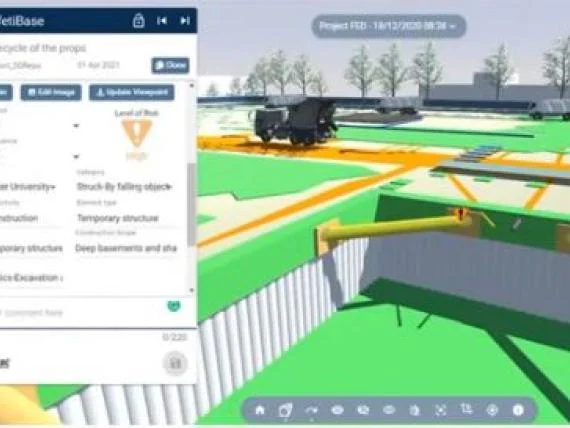


For the past two years Discovering Safety has been working with the construction industry, academia and tech providers to develop a library of standardised data and processes which can be incorporated into visualisation and modelling tools, such as Building Information Modelling (BIM), to mitigate safety risks in construction.
As an extension of this work, a new, innovative trial has been started that will pioneer the use of sensors, which will be physically attached to people and plant and digitally linked to a BIM model in order to create safety zones.
In construction, the use of safety zones by contractors is common across a range of hazards and risks encountered on site. It is hoped that adding sensors to people and physical barriers will improve zonal procedure accuracy and help to manage out risk to workers before harm can occur. But, there is a need to explore the benefits of zoning further, when used alongside new, responsive technologies.
The trial will take place on a live construction project at AstraZeneca’s Macclesfield Campus with the aim of engaging project clients, designers, contractors and site-based staff to adopt new ways of harnessing digital technology to improve health and safety outcomes. The results will show how effective these preventive measures are to industry.
Gordon Crick, technical lead for Discovering Safety described that “this trial is made possible by a five-way partnership between powerful innovators in the construction industry: The AstraZeneca construction team (led by Dave Ayres and Brian Street), the Main Contractor; Dalkia, who will be building the new extension, and the technology companies Plinx and Asite 3D Repo.”
The first step in the trial is to plan out the safety zones on a BIM model in order to inform how zones can be demarcated on site using sensors. Then these zones will be monitored using the BIM interface. The monitoring information will be used to improve week-on-week management of the safety zones, and perhaps more importantly, used to feed back information to planners and designers about how effective these preventive measures are.
The BIM model uses Asite 3D Repo’s SafetiBase software. The technology to create, view and link data to models is not new, nor is the use of sensors on site linked to local networks, however the ability to link and view feedback information directly on a construction design 3D/4D model interface has not been demonstrated before.
ASite 3D Repo specialises in BIM technologies. Their mission is to remove technological barriers to collaboration in order to create a better built environment. Jozef Dobos of Asite 3D Repo told us: ”For a number of years now, our customers have been able to virtually identify health and safety risks within the 3D BIM environment using SafetiBase. But we wanted to provide more feedback from the construction sites too. In this project, for the first time, we are linking the virtual with the physical, thanks to the integration of wearable ‘Internet of Things’ (IoT) sensors by Plinx which is really exciting.”
Plinx is a technology company that set out to helping partners make step-changes in performance by using smart technology. Tommy Williams of Plinx is responsible for the site-based deployment of sensors to demarcate safety zones on site. “This project builds upon Plinx’s work in the Industrial Safetytech Regulatory Sandbox project: connecting sensors and 4D models to empower stakeholders in foreseeing on-site hazards, using safety zones for protection and informing improved future implementation. This first-of-a-kind solution will demonstrate how to connect commercially available technologies in order to drive improved safety performance.”
Dalkia, a subsidiary of EDF Group, consider energy performance at the design and construction stage. They told us: “At Dalkia, everything starts with health, safety and wellbeing, which is why we’re thrilled to be a part of this ground-breaking trial. The integration of real-time feedback from such a diverse sensor network into a BIM model signifies more than just an advancement in technology; it represents a forward leap in creating smarter, safer, and more responsive construction environments. Our hope is that this initiative will pave the way for a more proactive, data-driven approach to safety, setting a new standard for the entire industry.”
AstraZeneca is a global pharmaceutical company with a major UK presence that pushes the boundaries of science to deliver life-changing medicines. Dave Ayres said “Learning from our last innovative project in Discovering Safety; the benefits from a client perspective were sometimes surprising. The 3D modelling was particularly useful for our end-user team who were able to make some fundamental changes to the design long before they had any impact on the schedule.” Brian Street added that “the need to engage designers and contractors early to develop the 3D model and to plan the safety zones, reinforces the strengths of collaborative working and has many other spin-off benefits.”
It is expected that the outputs from the work will:
- demonstrate the feasibility of monitoring both successful and unsuccessful performance of a safety zone on a construction site during the construction phase
- demonstrate how high-quality information from the sensors on site can be visualised and analysed using a 3D model via a playback scenario, in order to inform future decisions of site planners and designers
- provide a foundation for generating guidance and best practice for the industry
- contribute to HSE knowledge about effectiveness of digital tools in construction
- contribute to health, safety and productivity by reducing waste and loss in construction
This trial has now concluded. The findings are published in a report which you can view here.
More information
Two years ago Discovering Safety and AstraZeneca piloted a design risk trial for the Construction Risk Library project using the SafetiBase software. This project was written up in a case study which can be accessed here: https://3drepo.com/resources/case-studies/astrazeneca-visualising-construction-safety-risks
Related Content
